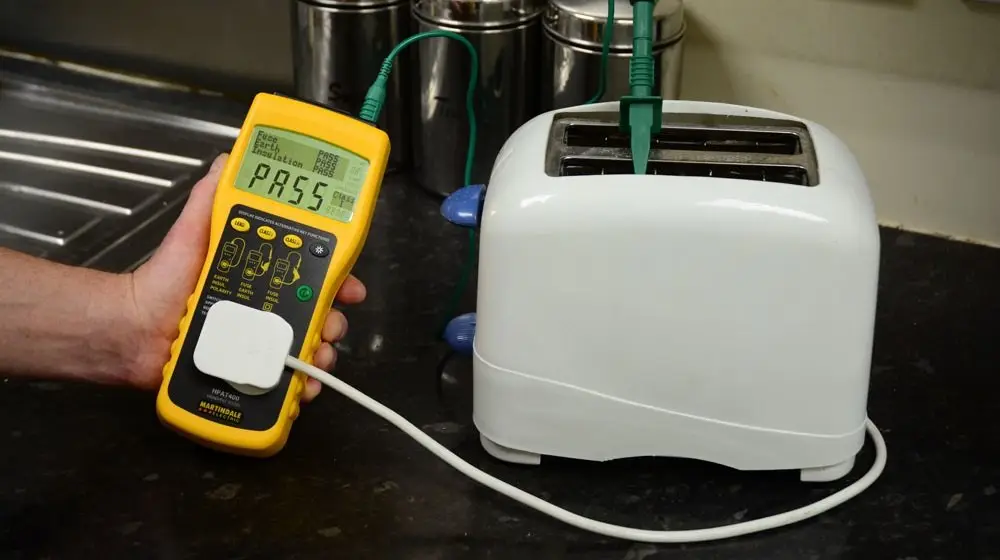Why do I need a PAT test?
You must have seen them at work,school or in your rented accomodation? The labels attached to electrical appliances with a pass written on them, dated quite recently? These are the result of a PAT test or Portable Appliance Test that is a legal obligation for employers or landlords to check that electrical appliances are fit for purpose and do not present a fire or electric shock risk.
It is not a legal obligation to PAT test electrical appliances in your home but the Health and Safety at Work Act and the Housing Act states that it is a requirement in a work setting and an obligation for landlords. So it is not a legal requirement as of 2023 for landlords to get their electrical appliances tested but electrical items in rented accommodation need to be in a safe condition in case of fire which is the whole point of a PAT test.

How much does a PAT test cost?
A PAT test can be conducted quite quickly in a small office setting or one bedroom flat so should not take longer than an hour. For larger properties with lots of electrical equipment and appliances you can expect to pay more as it will take a lot longer to complete the inspection. Some PAT testers will charge you by the hour or size of property, others will charge per electrical appliance which will include wiring, stationary equipment, IT equipment, moveable equipment, portable appliances and hand held appliances. You will be surprised what these guys can stick a sticker on!
How much you pay will depend a lot on your location in the UK as it tends to be more expensive in the South East of England. On average the cost of a PAT test on up to 30 items should cost no more than £60. For this you will get a PAT test certificate and a lot of electrical items in good working order and a fresh pass sticker.
If the working environment is testing or represents a danger to the tester expect to pay more. Busy working kitchens or machine shops are an example of this. As said before, the more electrical appliances, the more you will have to pay.
Who does a PAT test?
You might be surprised to learn that you don’t need to be a qualified electrician to conduct a PAT test but you do need to have taken a PAT testing course to be let loose on all those electrical appliances.
This is something qualified electricians will have done so unless you want to take the course and have time to inspect your appliances it might be better to hire an electrician. They can also help identify other electrical safety issues with your property that an untrained eye might miss.
Either way you will also need the equipment to conduct a test and there are a number of PAT testing kits to make your life a hell of a lot easier. Unfortunately they are not cheap. The PAT testing machines start from £200 and go up to £1750 depending on the specification which includes things like printing labels to stick on the tested appliances.
Each electrical item is different and may require a different way to be tested. So having an understanding of not only being able to visually inspect the appliance for its safety but also to be able to test the appliance using authorised PAT testing equipment correctly is important.
What is measured in a PAT test
The first part of a PAT test is to visually inspect the appliance and lead and then to conduct a test using a custom PAT testing device. The test will check for current leakage, earth continuity, lead polarity and insulation resistance. The appliance is plugged into the PAT machine and probes are fixed to the appliance so that the machine can show whether it has passed or failed. Each appliance is then given a pass or fail sticker.
There is no definition of what a portable electrical appliance is and it doesn’t have to be something you carry around with you. Basically if it's got a plug socket attached to it, it should be tested but there are differences.
Electrical appliances are categorised as class I,II and III.
-
Class III: refers to low voltage items. They are the least dangerous and therefore the safest class of electrical appliance. Class III items do not need to be PAT tested, although any charging leads should be checked.
-
Class II: includes electrical equipment that doesn’t rely on earth for protection. These should be tested.
-
Class I: relates to equipment that has basic insulation and needs earth for protection.
How often do I need to do a PAT test?
There are no hard and fast rules as to when you should be conducting a PAT test and this depends on the use of the electrical equipment, the environment they are used in and the class of the appliance.
How do I hire an electrician to conduct a PAT test?
There are companies dedicated to PAT testing but the majority of PAT tests are conducted by qualified electricians. Get a quote to PAT test your property today from electricians in your local area. Simply post your job on HaMuch, get the electrician rates and talk to electricians that fit your budget.